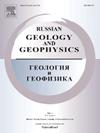Sumian Basalts and Basaltic Andesites of the Karelian Province of the Fennoscandian Shield: Geologic Position, Composition, and Formation Conditions
IF 1
4区 地球科学
Q3 GEOSCIENCES, MULTIDISCIPLINARY
引用次数: 0
Abstract
––We performed a petrochemical study and determined the Sm–Nd isotope composition of the Sumian (early Paleoproterozoic) mafic metavolcanic rocks in the Vodlozero domain (Semch’, Kumsa, and Kamennye Ozera structures) and the Central Karelian domain (Lake Vottomuks and Lake Kogu structures, the western flank of the Lekhta structure) of the Karelian province of the Fennoscandian Shield and compared them with the coeval volcanic rocks of the Kola–Norwegian province and the intrusive rocks of the Karelian and Belomorian provinces. The Sumian mafic rocks intruding the rocks of the Archean domains with different crust ages (>3.1 and 2.7–2.8 Ga) have similar geochemical characteristics (SiO2 = 44–55 wt.%, MgO = 5–14 wt.%; LREE enrichment, (La/Yb)N = 5–17) and similar values of εNd(T) (from –2.7 to –0.5) and TNd(DM) (from 3.0 to 2.7 Ga), which distinguishes them from their Archean analogues and indicates a single large magma source. The crustal contamination of the primary melts did not exceed 15% and could not determine the isotope-geochemical specifics of the Sumian mafic rocks. Their specific composition is better explained by the model of the formation of primary melts through the low-pressure (2.5–3.0 GPa) melting of the Neoarchean metasomatized zones of the subcontinental lithospheric mantle, with the addition of the primitive-mantle melts. In the period 2.41–2.45 Ga, the early Paleoproterozoic mafic rocks of the Fennoscandian Shield formed in the intracontinental magma generation setting.芬诺斯堪的地盾卡累利阿省苏门玄武岩和玄武岩安山岩的地质位置、成分和形成条件
—对vollozero域(Semch’、Kumsa和kamenye Ozera构造)和Central Karelian域(Vottomuks湖和Kogu湖构造)的苏米期(早古元古代)基性变质火山岩进行了Sm-Nd同位素组成的研究。并将它们与科拉-挪威省的同时期火山岩以及卡累利阿省和贝洛莫里安省的侵入岩进行了比较。侵入太古宙不同地壳年龄(> - 3.1和2.7-2.8 Ga)的苏美镁质岩石具有相似的地球化学特征(SiO2 = 44-55 wt.%, MgO = 5-14 wt.%;LREE富集(La/Yb)N = 5 ~ 17), εNd(T)值(-2.7 ~ -0.5)和TNd(DM)值(3.0 ~ 2.7 Ga)相近,与太古宙类似岩浆源有明显区别,表明其岩浆源为单一大岩浆源。原生熔体的地壳污染不超过15%,不能确定苏米亚基性岩石的同位素地球化学特征。它们的具体组成可以用次级大陆岩石圈地幔新太古代交代带低压(2.5-3.0 GPa)熔融形成原生熔体的模型来解释,并加入了原始地幔熔体。2.41 ~ 2.45 Ga时期,芬诺斯坎德地盾早古元古代基性岩形成于陆内岩浆生成环境。
本文章由计算机程序翻译,如有差异,请以英文原文为准。
求助全文
约1分钟内获得全文
求助全文
来源期刊

Russian Geology and Geophysics
地学-地球科学综合
CiteScore
2.00
自引率
18.20%
发文量
95
审稿时长
4-8 weeks
期刊介绍:
The journal publishes original reports of theoretical and methodological nature in the fields of geology, geophysics, and geochemistry, which contain data on composition and structure of the Earth''s crust and mantle, describes processes of formation and general regularities of commercial mineral occurrences, investigations on development and application of geological-geophysical methods for their revealing. As to works of regional nature, accelerated publication are available for original papers on a variety of problems of comparative geology taking into account specific character of Siberia, adjacent Asian countries and water areas. The journal will also publish reviews, critical articles, chronicle of the most important scientific events, and advertisements.
 求助内容:
求助内容: 应助结果提醒方式:
应助结果提醒方式:


